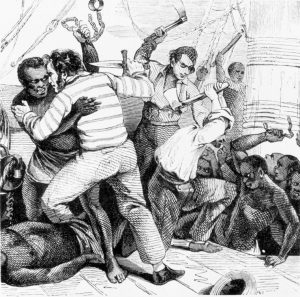
Stephanie Saffore
ENG 302- Prof. Kappes
3/26/18
A Sisyphean Undertaking: Slave Resistance and Revolts
Aphra Behn’s novella Oroonoko, tells the tale of a young prince that, like so many before him, was tricked into slavery. Despite this manipulation however, Oroonoko takes an extremely passive role in his capture, as well as most of his time as a slave. The illustration titled “Revolte sur un bâtiment negrier” or Slave Rebellion by Albert Laporte from the Schomburg Center’s digital archive depicts a far less peaceful point of view of the slave trader’s entrapment. Behn’s novella Oroonoko presents a narrative in direct conflict with the horrors of the slave trade. She not only glosses over the violent inhumane conditions of their capture on slave ships, but also seems to humanize the traders and masters.
Upon introduction, the character of Oroonoko is described as being “Graceful”, “noble”, with a “finely shaped mouth” (13). He is the epitome of beauty and grace, a supposed rarity among Africans. Even his skin complexion is differentiated. He has a “jett” tone, completely unlike the “rust” color that is so common amongst his people. Oroonoko’s fairness is only valid or legitimate, because he fits a certain aesthetic: the white European ideal of beauty. His character is whitewashed and romanticized beyond the point of recognition.
Laporte’s picture however, does no such thing. He illustrates one of the numerous slave rebellions. The prisoners are shown to be furious, fighting for their lives and freedom. They are frowning, and curling their lips up in disgust at the men who took them prisoner. They are not dressed up to be something they are not, or held to some arbitrary standard of beauty. There is in fact, a lot of shadowing technique used to give the slaves fighting back an extremely menacing look. This contrasts greatly with the whites of their eyes. The slave traders however, are far more opaque and grey, their eyes and faces being drawn with very little detail. This gives them the appearance of indifference, as if this fight is a mere inconvenience for their business.
What is perhaps even more problematic is the way in which Oroonoko is captured and his subsequent reactions. The slave trader keeps him entertained with baubles and content with food and wine (30-31). After lying about freeing him once they reach shore, the captain convinces Oroonoko to make his people more compliant. He successfully makes his people more accepting of their fate, having believed their captors would honor their word. This goes on for a while, even after he has been sold to Trefry. Oroonoko genuinely believes that his master, being the benevolent gentleman that he is, will set him and free and let him truly be with Imoinda.
Laporte’s illustration is the pure antithesis of Behn’s story. Those that had been captured revolted and fought back against the traders. Despite the fact that their captors wielded knives and axes, they continuously fought back in every sense of the word. They even go so far as to use their fetters as weapons against their oppressors. The narrator in Behn’s story tells us that slavery was a fate worse than death. That being the case, it is no surprise that those captured would rebel, even if they met their end. History tells us that despite their unfortunate fate, their continuous revolts saved an estimated million people from falling into the clutches of the evil institution.
In visual art and in literature, we immortalize and tell stories for the generations to come. Art tends to imitate life, and Aphra Behn’s tale does indeed show the horrors of slavery. However, it is also far removed from the realities of what it meant to be captured and become someone’s property. In her tale, the ugly truth is muted in favor of flowery language and excessive romance. Albert Laporte’s illustration offers a far more grounded depiction of an uphill battle. Though these mediums seem to tell opposing stories, the white men in the picture appear to be dominating those in revolt. Creative license is and can be a wonderful thing. History however, is only as accurate as we allow it to be. With that in mind, those who record it have a duty not to dress it up and make it “beautiful” or entertaining, but as accurate as possible.

